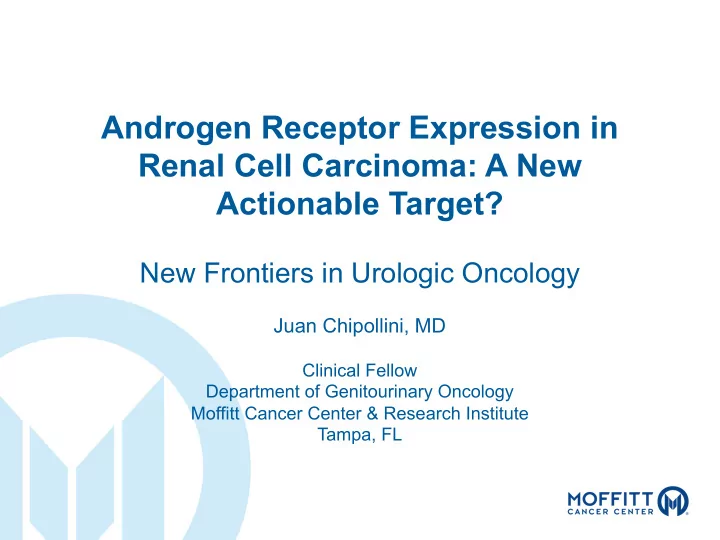

Androgen Receptor Expression in Renal Cell Carcinoma: A New Actionable Target? New Frontiers in Urologic Oncology Juan Chipollini, MD Clinical Fellow Department of Genitourinary Oncology Moffitt Cancer Center & Research Institute Tampa, FL
Disclaimers • No disclosures
Objectives • To discuss the role of androgen receptor (AR) expression in renal cell carcinoma (RCC). • To present an exploratory analysis of AR expression from a single institutional cohort of patients.
Introduction • RCC is the most common type of kidney cancer and the most lethal urological malignancy. • Many cases of metastatic RCC are resistant to conventional systemic therapies including chemotherapy. • Thus, continued understanding on the molecular mechanisms of RCC progression is needed in finding novel therapies in the fight against RCC.
Introduction • The mechanism of AR involvement in carcinogenesis is poorly understood. • Studies have suggested AR inhibits the tumor suppressor P53 in hepatocellular carcinoma and activates G protein signaling cascades in ovarian cancer. 1,2 • Other studies have shown AR could promote RCC metastasis via modulation of the HIF2a-VEGF pathway. 3 • These newly identified mechanisms may provide us with newer therapeutic approaches in RCC progression.
Purpose • We assess AR expression at the protein level in archival RCCs of various histologies.
Methods • We identified 66 patients with RCC surgically treated at Moffitt Cancer Center from 2003 through 2015. • Formalin-fixed paraffin-embedded blocks were retrieved from Pathology and representative slides were selected for tissue microarray (TMA) construction by sampling three cores of 1-mm diameter per each case.
Methods • Immunohistochemical (IHC) staining was then performed with the Ventana Discovery XT automated system (Ventana Medical Systems, Tucson, AZ) using a anti-AR rabbit monoclonal primary antibody (Ventana SP107 rabbit mab; Rocklin, CA, USA). Slides were counterstained with Hematoxylin, dehydrated and cover slipped as per normal laboratory protocol. • Binary expression status [Negative (0) vs. positive ( ≥ 1+ in at least 1% of tumor cells)] was generated for statistical analysis. • Survival outcomes were evaluated using the Kaplan Meier method. Logistic regression and Cox proportional hazard was used to assess prognostic associations.
Variable Level N % 60 (53-69) 66 100 Age (year), median (IQR) BMI (kg/m2), median (IQR ) 29.5 (24.3-32.6) 54 81.8 6.9 (3.5-10.8) 66 100 Tumor size (cm), median (IQR) Follow-up (month), median (IQR) 40.8 (25.5-68.9) 66 100 Male 50 75.8 Gender Female 16 24.2 Race White 38 57.6 Black 5 7.6 Hispanic 7 10.6 Karnofsky Performance Status ≤ 80 16 24.2 > 80 44 66.7 AJCC tumor stage pT1 26 39.4 pT2 11 16.7 pT3 27 40.9 pT4 2 3 Grade 2 16 24.2 3 31 47 4 16 24.2 Features 14 21.2 Lymphovascular invasion Tumor necrosis 31 47 Perineural invasion 1 1.5 Tumor thrombus 11 16.7 Negative 61 92.4 Margin Positive 4 6.1 Histology Clear cell 21 31.8 Papillary I & II 25 37.8 Sarcomatoid 9 13.6 Collecting duct 1 1.5 Rhabdoid 6 9.1 Medullary 2 3 Translocation XP11.2 2 3
Results • In total, 56.1% of tumors expressed AR: – 66.7% in clear cell – 44.2% in non-clear histologies
Results • Five-year OS was 86.3 and 70.6%, respectively (log-rank p=0.040) HR = 0.35 (0.12-0.99), p = 0.050
Results • Five-year CSS was 89.5 and 70.6% for AR positive and negative tumors (log-rank p=0.072) HR = 0.35 (0.11-1.15), p = 0.084
Results • Five-year PFS was 71.5 and 49.6% for AR positive and negative tumors (log-rank p=0.064) HR = 0.44 (0.18-1.07), p = 0.072
Results T3/4 (29 events) OR (univariate) p OR (multivariate) p AR Negative Positive 0.11 (0.03-0.33) <0.001 0.10 (0.03-0.38) 0.001 Histology Clear Non-clear 2.6 (0.86-7.95) 0.091 1.43 (0.35-5.85) 0.620 Grade <2 >2 18.6 (2.26-152.3) 0.007 22.5 (2.26-223.8) 0.008
Conclusions • Our preliminary results indicate that AR expression appears to be a marker of indolent disease in RCC. • Inhibition of hormonal signaling may be putative in treatment therapies against this cancer type. • Whether AR plays a key role in RCC progression and what possible mechanisms may be involved remain to be defined. • Larger, prospective studies are needed to validate these results.
References • 1 Sasaki, M. Distribution of a single nucleotide polymorphism on codon 211 of the androgen receptor gene and its correlation with human renal cell cancer in Japanese patients. Biochem Biophys Res Commun. 2004 Aug 20;321(2):468-71. • 2 Weng-Lung, M. Androgen Receptor Is a New Potential Therapeutic Target for the Treatment of Hepatocellular Carcinoma. Gastroenterology. 2008 Sep;135(3):947-55, 955.e1-5. • 3 A. Mancuso, C.N. Sternberg. New treatments for metastatic kidney cancer. Can J Urol, 12 (suppl.) (2005), p. 66
Recommend
More recommend